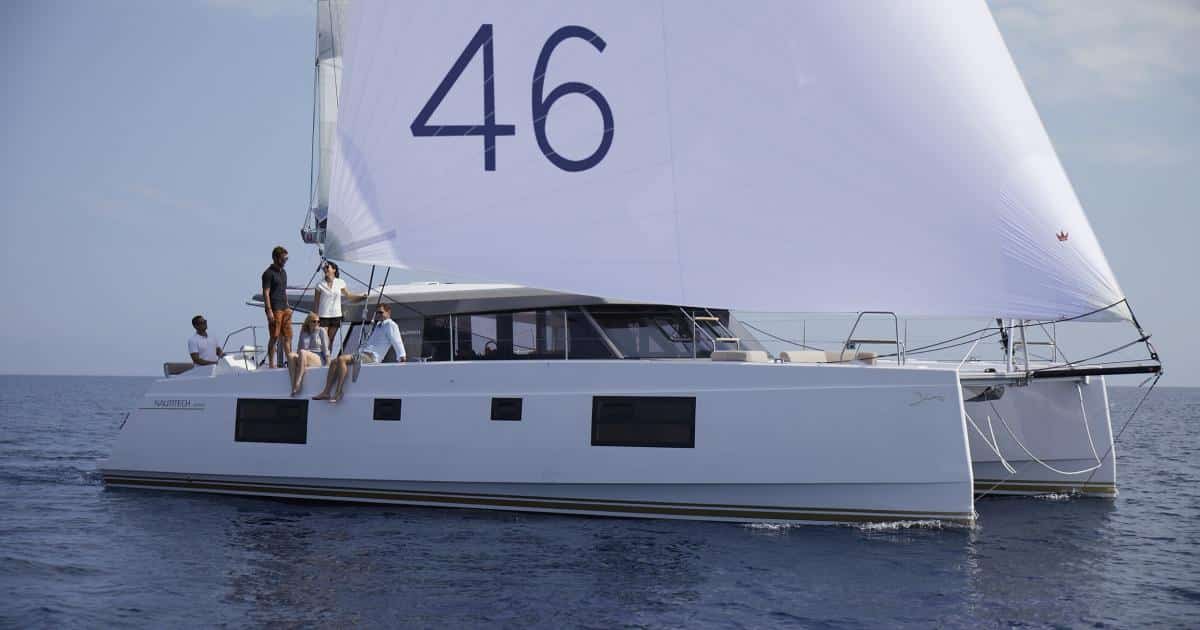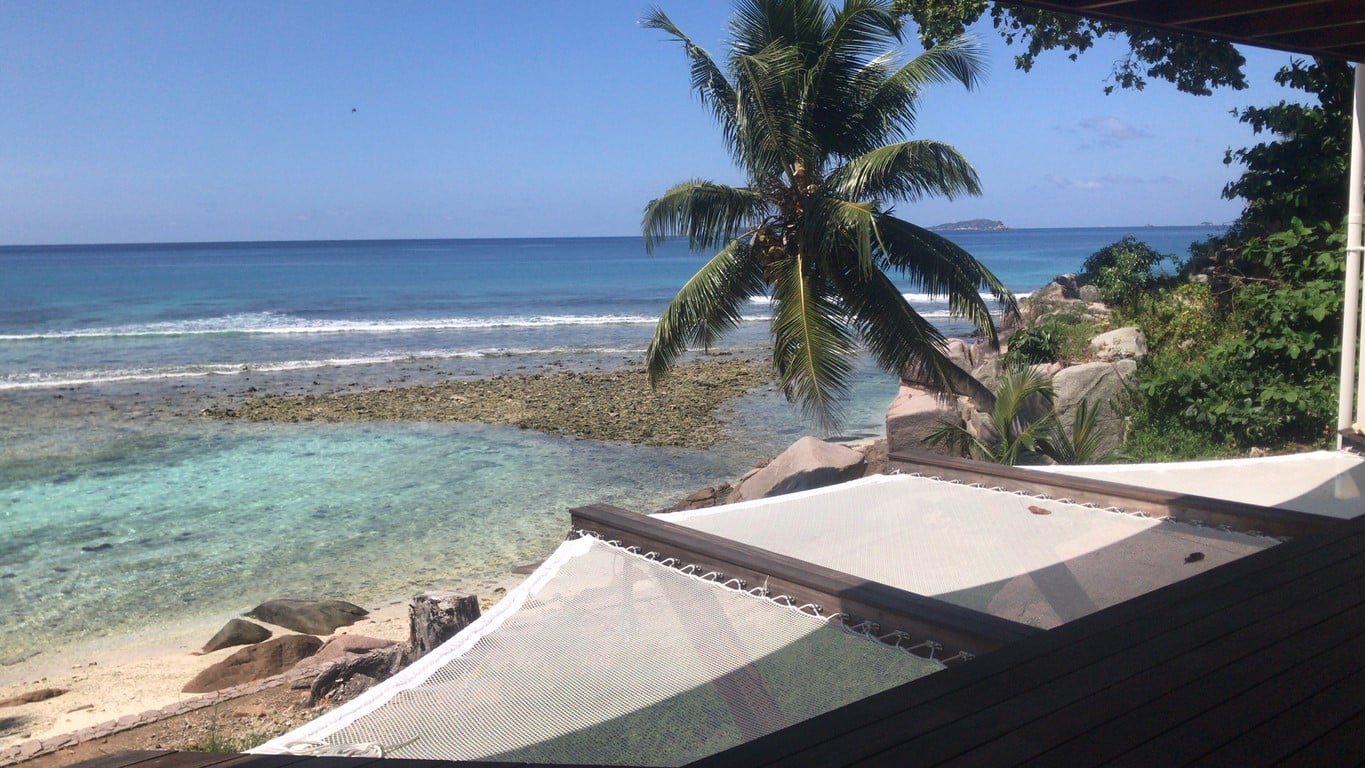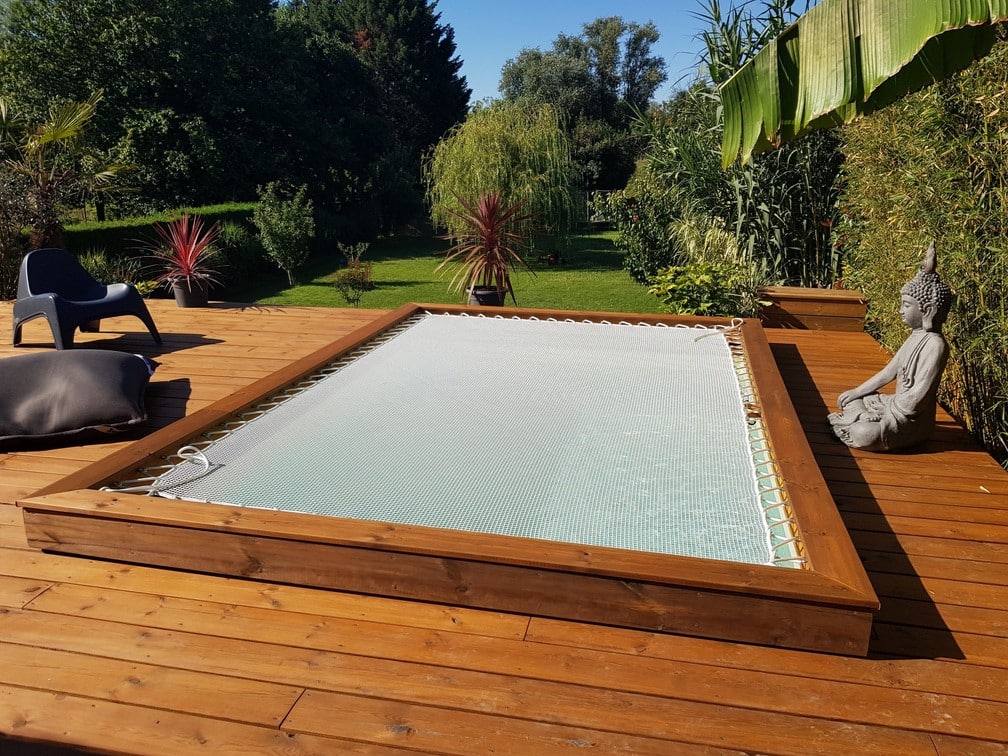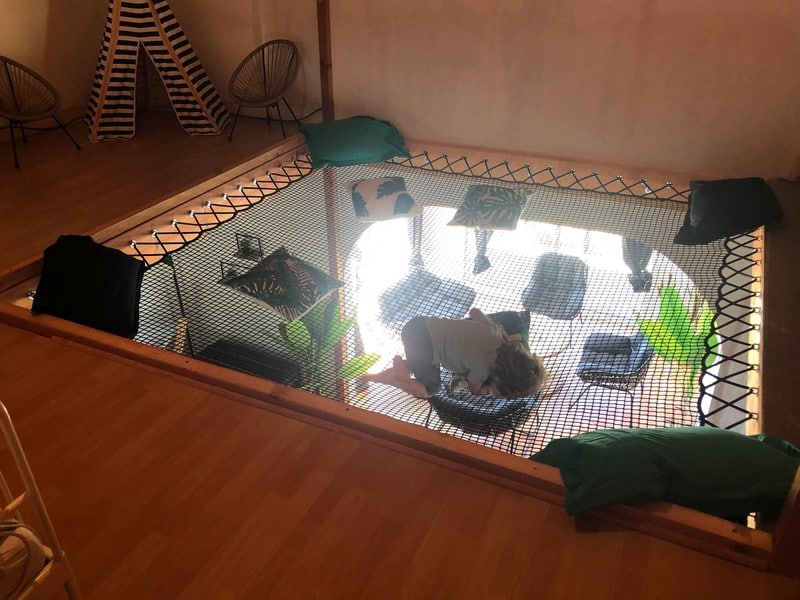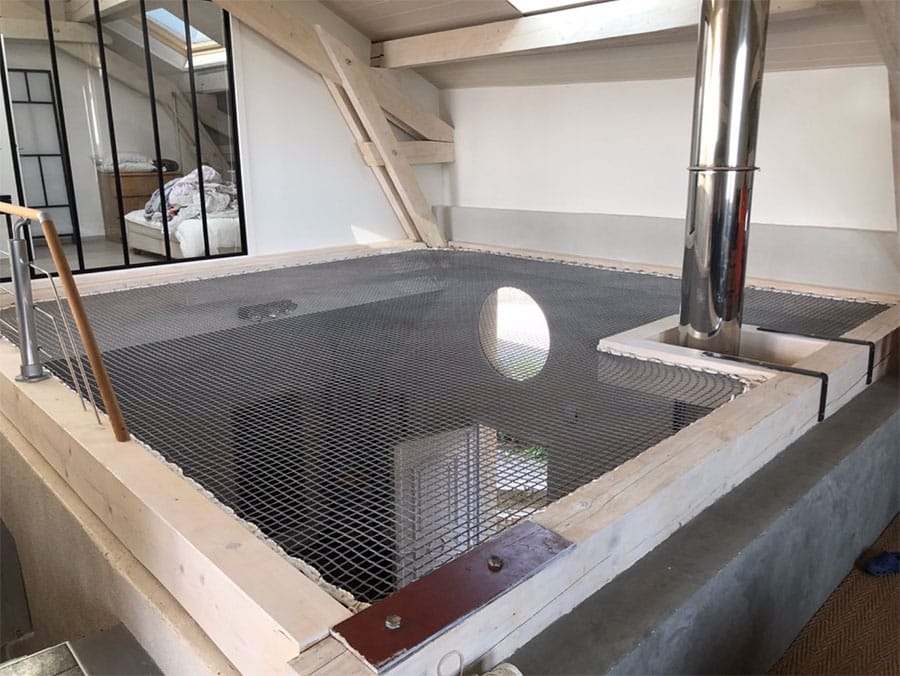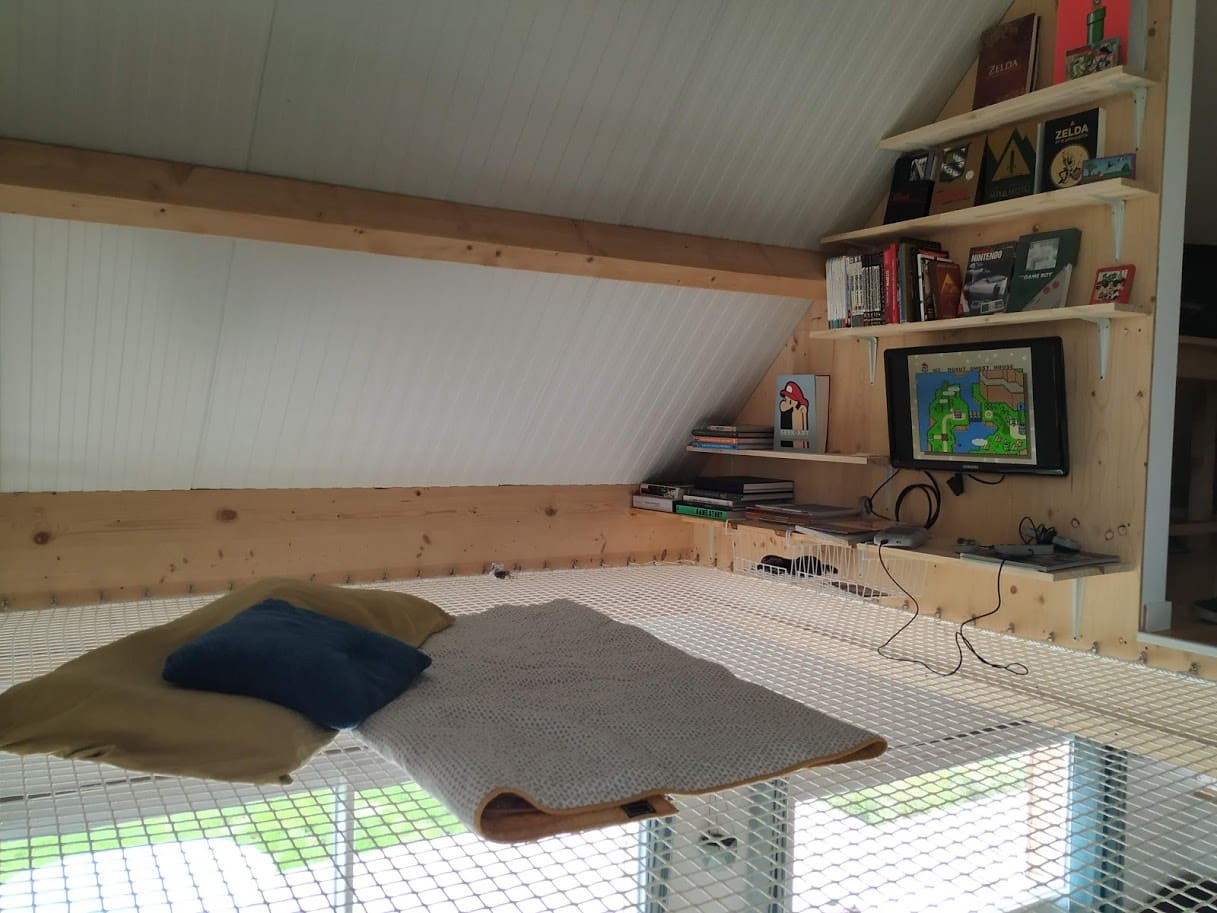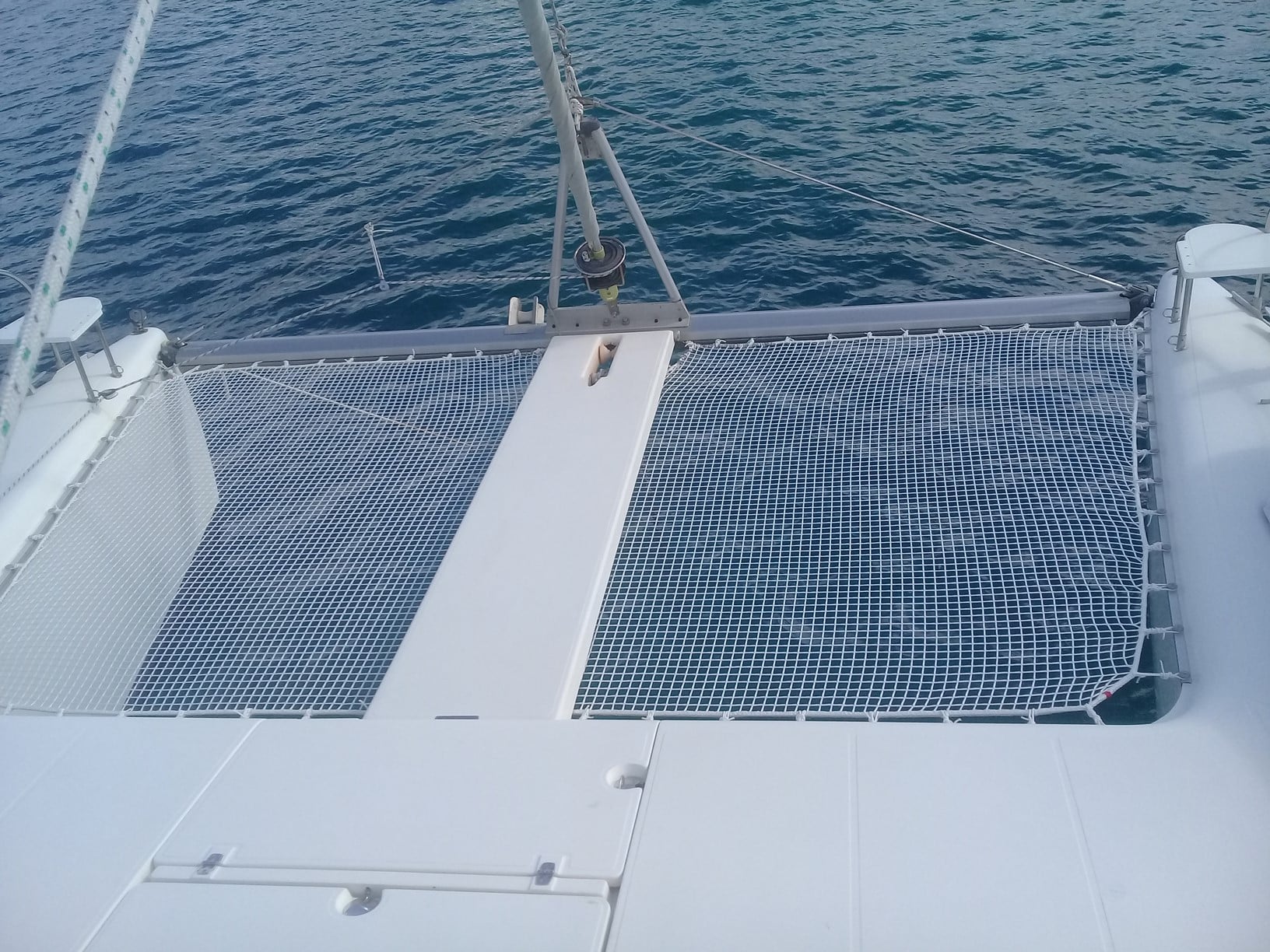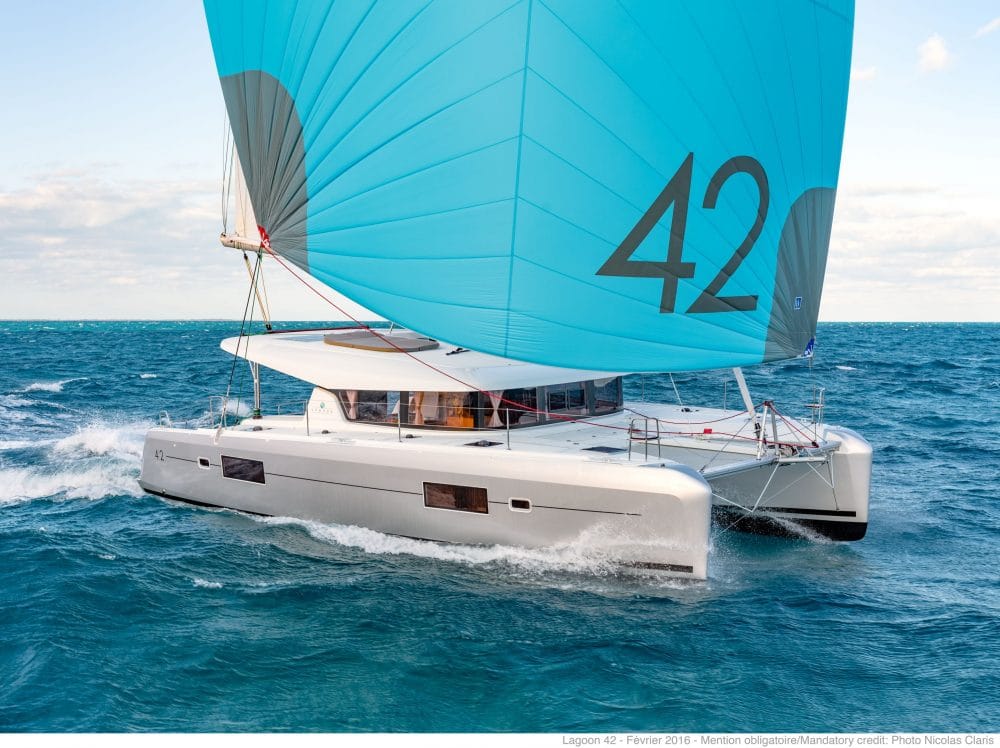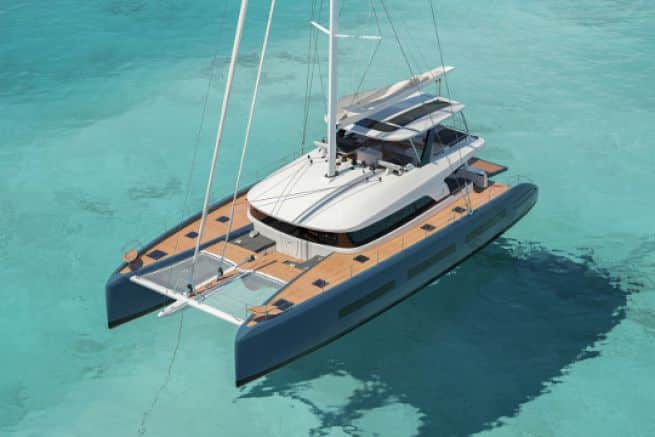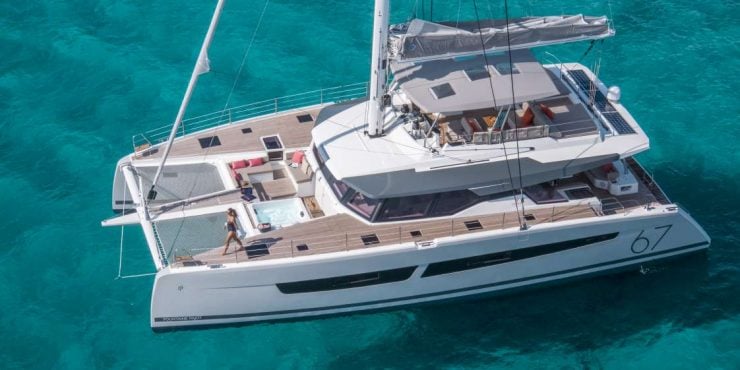Buying Guide for Trampoline Net for Nautitech
Nautitech is an essential French shipyard for all boat enthusiasts.
One of the largest shipyards, especially for catamarans, Nautitech was the first to create a saloon and cockpit on the same level to create a true open space.
Where to Find or Rent Nautitech Catamarans?
Many rental companies around the world offer Nautitech brand catamarans for rent.
They can be found in the Mediterranean basin, the Caribbean arc, or the Indian Ocean.
Companies like Dream Yacht Charter and Sunsail have and have had the famous Nautitech 82 in their fleet. This catamaran is specially designed for day trips or cabin charters.
Like its counterparts, Nautitech has managed to align a wide range of catamarans, from 39 feet to 54 feet. It's a shipyard that renews and offers catamarans even more adapted to demand.
Feelnets, which is a partner and supplier for the largest boat rental companies in the world, manufactures second-hand nets for all Nautitech boats worldwide.
Does Feelnets Make Nets for Older Models?
Nautitech has been building catamarans of various sizes for many years.
Some slightly older models like the Nautitech 395, Nautitech 441, Nautitech 442, or the Nautitech 495 are still sailing. Feelnets therefore has all the plans for making and replacing nets, for both new and old models.
Which Net to Choose?
Generally, Nautitech owners of 39 to 47 feet request and equip their catamarans with 30x30mm or 13x13mm mesh.
This is also the mesh we use to equip catamaran rental companies. It's also the material we recommend for transats.
The large ones like the 75 and 82 feet replace the trampolines with PVC mesh492 from Serge Ferrari.
This material is extremely resistant, the edges are welded and sewn to obtain greater resistance over time.
We offer trampolines with either the option of eyelets all around every 150mm.
Or the option with a sleeve and passage for a rod. This is recommended for 82-foot models, for example, or other large catamarans.
The Feelnets Service
For boat owners or renters, Feelnets has a network of partners worldwide who can receive your net if you can't be there to receive it yourself.
Our partner receives your net and you can pick it up at their offices whenever you want.
Your quote in less than 3 hours, delivery worldwide, many models in stock such as the Nautitech 40, Nautitech 395, and other models.
Feelnets is one of the leaders in replacing multihull nets worldwide.
Also a supplier for many shipyards such as HH Catamaran, Island Spirit, Corthinx...
A Safety Net for your Home
We all want our homes to be safe, comfortable, relaxing spaces where we can enjoy quality time with our families and friends. Many of us are conscious of hazards in our homes, which can increase the risk of accidents and injuries. If you’re looking for ways to enhance safety and keep your family safe, it’s an excellent idea to consider investing in a safety net. In this guide, we’ll explore some common uses of safety nets and outline the benefits they offer for homeowners.
For most of us, there’s no place like home. Our homes should be sanctuaries that make us feel safe, happy and calm. Sadly, our homes can harbour hazards and there is a risk of accidents and injuries, particularly if you have an apartment or a house with balconies, you have a swimming pool outside or you have young children and lots of staircases or mezzanine levels. Safety nets are designed to reduce the risk of accidents at home, providing peace of mind and extra protection for parents and homeowners.
How to use a safety net in your home
Safety nets provide barriers and additional protection in parts of the home that may pose a high risk of slips, trips and falls. Here are some popular uses of safety nets:
Make your balcony safe
Balconies are a stunning feature and they enable you to enjoy views and embrace al fresco living but they can be dangerous. If you have balconies on the upper levels of your home or you have an apartment with a balcony garden, you may be worried about the risk of falls, particularly if you have children. A balcony with safety netting will reduce the risk of falls from height while also providing additional security benefits and allowing the entire family to enjoy spending time together outdoors.
If you are a parent, you will probably have been in a situation where your heart rate has risen sharply while on holiday or visiting friends who have a balcony. Balconies are intriguing for kids and it can be incredibly fun to hang out together and soak up the sunshine. The trouble is that balconies carry a risk of falls and everybody’s worst nightmare is to see somebody slip. A safety net balcony is an excellent option for homeowners who have a balcony. With safety netting, you can make your balcony childproof and protect adult visitors too.
When choosing a safety net for your balcony, take time to double-check the measurements for a perfect fit, explore design options and opt for high-performance, quality materials.
Pool and trampoline safety netting
There are few things that are more fun than bouncing around on a trampoline or splashing around in the pool on a sunny day. Unfortunately, both trampolines and swimming pools can be dangerous, especially for young children.
Trampolines have become incredibly popular and they provide endless hours of fun for children and adults alike. While falling is part and parcel of the experience, there is a risk of falling off the trampoline without the relevant safety measures in place. If your child slips, or they misjudge their landing and they fall onto the ground, they could sustain severe injuries. Safety netting is a simple, effective means of keeping kids safe when they are bouncing and preventing them from falling off the protective mat.
Having a pool is wonderful but if you’re a parent, there may always be a nagging voice in your head that makes you anxious about your children being around the pool. Accidents can happen in an instant and the consequences of falling into a pool can be devastating. Pool nets are a brilliant idea for holiday homes and residential properties with swimming pools and Jacuzzis. Nets are a deterrent for young children and they also provide a safe surface if a child does crawl or try to jump into a pool.
Fencing and stair railing
Walking up and down the stairs may be second nature to adults, but if you have small children or you have family members with mobility issues or conditions that affect their balance, the staircase can be a major hazard. Falling and slipping on the stairs are among the most common types of household accidents. If you feel nervous every time your child goes near the stairs or you’re looking for effective ways to make your home safer for older relatives, for example, using safety nets is an excellent idea.
You can use safety nets to provide additional, more robust protection for landings, stairwells and staircases that have floating steps or open sides. Netting will prevent accidents and ensure that bodies are cushioned in the event of a slip or trip to lower the risk of serious injuries. Parents can also use netting as a means of blocking off staircases they don’t want their children to use and a deterrent that discourages playing on the stairs. For young children, climbing the stairs is an adventure but no parent wants the staircase to become the play area of choice in the home.
In addition to safety netting for staircases and stairwells, safety net security can also be beneficial for outdoor areas and parts of the home you may be keen to restrict access to or block off. Fencing nets provide additional security, enforcing barriers and boundaries to keep children and pets safe and prevent them from escaping. Nets can also deter people from wandering onto your property and provide more privacy.
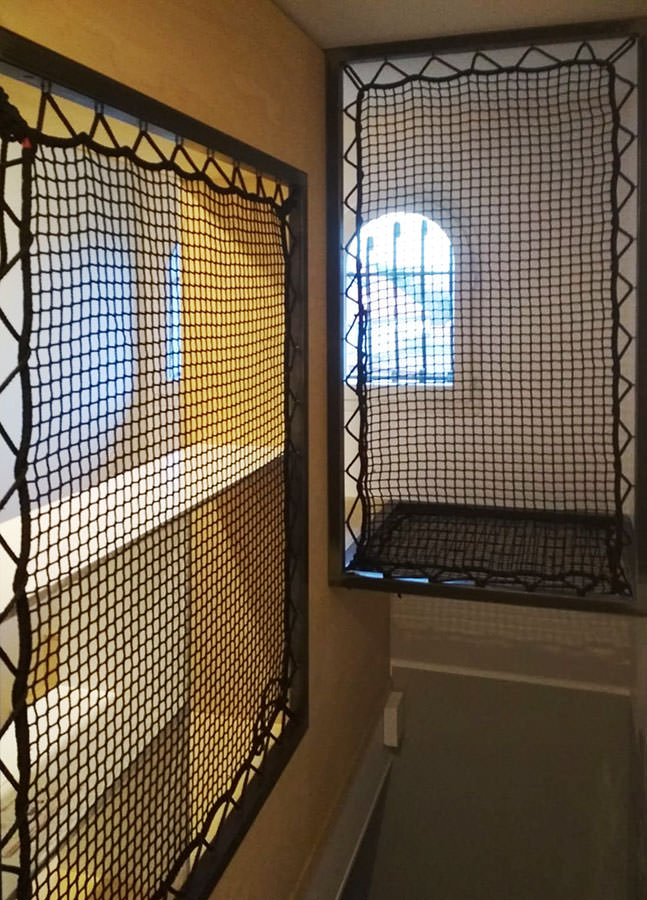
Feelnets: A custom safety net designer for your home
We all want our homes to be safe havens and it’s particularly important to prioritise safety when you have children or pets. Safety nets for the home provide an effective solution for reducing the risk of accidents, such as slips and falls, and keeping people safe. Whether you have a swimming pool, a balcony or staircases you’re keen to keep young children away from, using safety nets to childproof your home and keep adult visitors safe can help you turn your home into a secure sanctuary and lower stress and anxiety levels.
CONTACT US
Hotel or restaurant hung net: the utmost in luxury
In a previous article about terrace hung net we explained how safe and stylish they were. Therefore, it’s no surprise that 5-star hotels and restaurants make use of our outdoor and indoor nets. However, our nets aren’t just practical – they provide an elegant and exotic touch to any environment. Feelnets gives you an insight about a trend that goes beyond fashion.
Hotel or restaurant terrace hung net: the utmost in luxury
Exclusive hotels and restaurants are always looking for the most sophisticated materials. To provide the ultimate leisure spots, they opt for the hung nets experts: Feelnets.
Our brand has a long held expertise in nautical activities, and multihulls trampoline.
Our range of products are perfectly fit for outside use. Combining style and top resistance, our house nets are:
- Made from polyester fabric
- 13 x 13 mm mesh (0,51 x 0,51 inches)
- Black or white
- UV proof
We use custom size Sergio Ferrari 492 or 392 prestressed PVC mesh, with welded and stitched edges.
Our products’ reliability is the reason Feelnets became the leader in custom-made nets for exclusive hotels and restaurants worldwide. Using similar fabrics and processes to those for building multihulls, we guarantee a high standard of durability.
DO YOU FANCY AN XXL HAMMOCK ABOVE WATER?
Feelnets is partner with the Hilton Bora-Bora and other hotels in the Indian Ocean and Asia. We can deliver all over the world and meet all your demands.
Outdoor, as a terrace extension in a suite or a restaurant, the hung net provides the opportunity to relax while enjoying the sound of the waves beneath. Hotels with swimming pools or immediately beside a lake or the sea can easily set-up a hung net above, by installing a wooden frame at the end of their terrace.
SWAPPING SUNBEDS FOT OUTDOOR TERRACE NETS
Why using tiny sun beds on the terrace of your hotel or restaurant? Being custom made, an outdoor terrace net can be any size you like. It’s now possible to create various leisure spots, in different sizes and shapes to fill your terrace with luxurious cosy places.
A HUNG NET INSIDE YOUR HOTEL OR RESTAURANT
Creating a mezzanine in an empty space is really quick and easy with an indoor custom net, whatever the size of the mezzanine you want.
In this example, the customer is an hotel manager who wanted to preserve the luminosity and the originality of the space but still secure it with vertical and horizontal black mesh.
Feelnets, Custom net Designer for luxury hotels
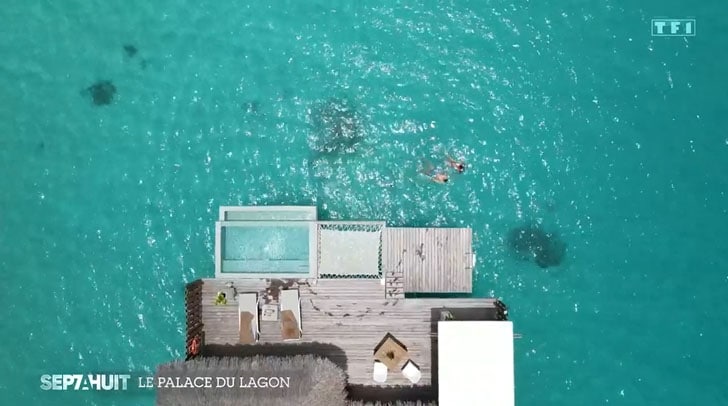
Hotel and restaurant managers, don’t think twice, chose style and exclusivity with an indoor custom net.
As seen on the TV show TF1 Sept à Huit of March 14, 2021.
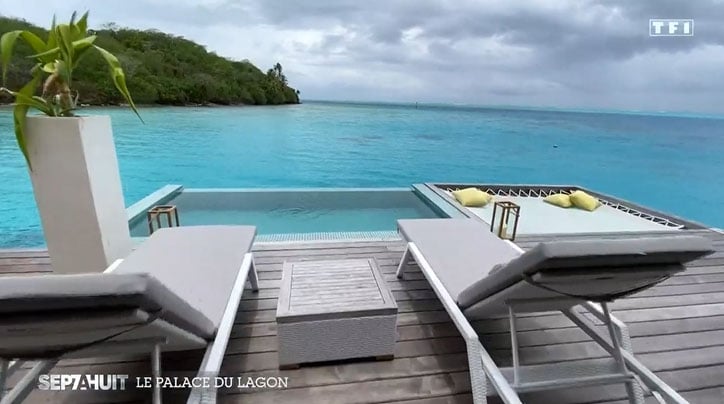
--
Feelnets, Custom net Designer for luxury hotels
--
>> CONTACT US for more information: contact@feelnets.com
A house net to secure your terrace
The terrace is the ultimate place for leisure, where you want light materials, and a holiday wind blowing over this dreamy and festive outdoor space. The outdoor house net perfectly accommodates safety, design and convenience. Let Feelnets, your net expert, tell you about the strong points of a terrace net. As a guardrail, it will secure an empty space or a swimming pool. It can also be used as a leisure spot.
A house net to secure your terrace
The house net has settled on our terraces for quite a while now, bringing along a bit of leisure and softness; but it can also help securing them.
House nets are widely acclaimed for the safety they offer on a terrace, by preventing falls. They do this without blocking the view. You can build a wooden or concrete frame on your terrace and set-up an original guardrail, completely secured, made of weatherproof tension rope.
The house net is an excellent railing on a terrace, because it does not block the view. It can also be very useful to secure stairs outdoors.
Make your swimming-pool safe with an outdoor house net
You can also set your outdoor house net over your swimming pool. It will prevent your kids (or your pets) from falling inside when you are not watching.
It is also useful as it will help to keep your swimming pool clean, as the mesh will prevent leaves from getting into the water.
An outdoor house net to create a leisure spot on your terrace
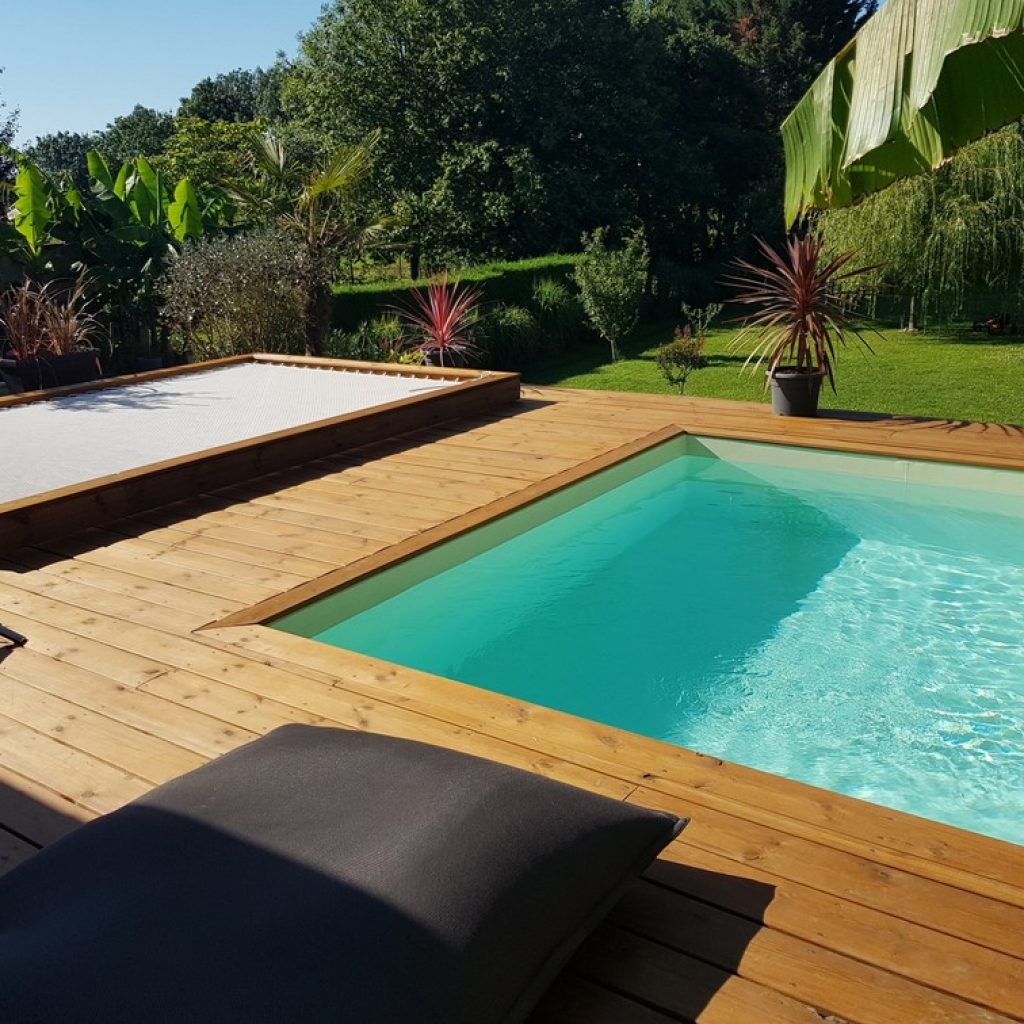
Close your eyes, and let us bring holidays to your own terrace. Even better, feel like you are sailing in a catamaran over the sea. This is what you get when you set-up an outdoor net on your terrace to create a leisure spot. It’s a sailing device that feeds your dreams.
As a matter of fact, if you own a wooden terrace, you can build a frame and set-up a house net inside, making your own giant hammock. A great replacement for sunbeds, bringing luxury and cosiness to your outside space.
Completely weatherproof (sun, rain, wind…), the Feelnets custom house netsare a perfect match with outdoor life.
Our 6 mm (0,23 inches) multistrand polyester rope is highly resistant (over 1700 kilos/ 267 pounds), sun-proof, and available in white, black, red, blue, sand, and green.
All over the world, our luxury hotelspartners use this rope to fix and set-up their sunbeds and hammocks.
Create an additional space with an outdoor house net
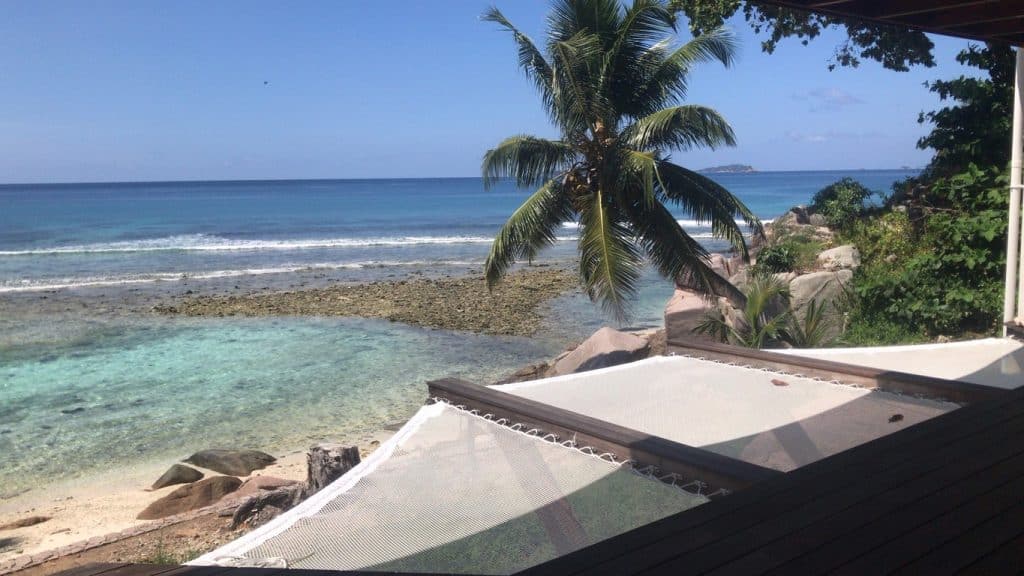
Need more space on your terrace? Why don’t you use a custom net to create more space? Used as a terrace extension, a house net allows you to make it grow… without any risk! Thanks to the weight capacity of the mesh (200kg per square metre), it can bear up to 5 adults*.
Moreover, it costs up to six times less than a concrete or a glass extension and is much easier to build.
—
>> CONTACT US for more information: contact@feelnets.com
10 ideas to optimize your living space
The house net has been one of the major trends in decoration, indoor architecture, and to optimize your living space. The solid rope is stylish and secure, and can be used horizontally or vertically, as a trampoline or a catamaran net. Thanks to its ever-growing success, it can be found in many homes, hotels and companies. Where can you set it up? For what type of space? Feelnets, custom net maker, brings you ten ideas to improve your indoor and outdoor spaces with a house net.
1. Filling an empty mezzanine space and gaining more surface
This is the most common way to use an indoor house net. When you create or convert a floor in an existing house, it’s not always easy to add a new stairway. And when you’re a family, you want to keep everyone together in the house (even more when you have children), to be with the kids when they play, or relax above your head.
The house net is an easy way to create a mezzanine. It can be set up in any empty space. It can be a playground, a leisure place, and a connecting device all in one. Moreover, the hung mezzanine let the air and the light through.
Discover ourFeelnetscustom-made productions.
2. Creating an extra playground for children to optimize your living space
As soon as your house net is hung, be ready for your children to storm in, and set up camp. As a real indoor trampoline, the house net has an undeniably fun side. It’s also a safe playground where you will be able to watch over your children from another part of the house.
Feelnets, expert in custom-made house nets, produce many net playgroundsthat you can discoverhere.
3. A partition in your living environment that lets the light through
There is a large living space in your house, and you want to clearly define the practical aspects of your room: office, living room, kitchen, leisure area… However you don’t want to lose interactions with your family and you want the light to flow everywhere. Rather than add a closed partition, a large piece of invasive furniture or a rather expensive studio window, setting up a horizontal house net will allow you to optimize your living space in a flexible way.
You can make up your mind by visiting our page room partitions with horizontal nets. Discover our photos.
4. A house net to secure your interior: railing for a mezzanine or an open floor
Whatever type of mezzanine you have, very often you will need to use a railing to prevent falls. You can choose between wood, steel, glass, cables, aluminium… or rope! Your railing can be a tensed net over the whole horizontal surface, with maximal security, as nobody will be able to climb above (unlike “traditional” railings).
This railing can also be used over a regular railing frame if you don’t want it to be too obvious.
Discover our railings creations here.
5. A unique railing for your terrace
House nets can also be used outside. They are the ideal choice to secure a terrace, preventing falls without blocking the view. Set up a wooden, concrete or steel frame on your terrace and add a net to it and you will have a unique and secure railing, with tensed weatherproof rope.
Feelnets is also acatamaran net expert, that’s why all our nets are sun-proof, and durable.
6. Stair railings
Sometimes design and family life can be unhappy bedfellows. For example, a hanging staircase can be very dangerous for small children. To avoid ruining a beautiful design we suggest a house net railing. Covering the whole open side of your staircase, it will provide absolute safety.
Discover photos of Feelnets staircase railing creations.
7. A giant hammock, close to your swimming pool, and over your terrace
Cosiness is one of our hung nets greatest assets. You can create a giant custom sized hammock, to lie down in and read or relax. It’s particularly enjoyable on a terrace, near a swimming pool. It can be set-up on any frame, and could be embedded in a wooden terrace.
Feelnets provides custom-made nets for many hotels, which discreetly blend into the landscape. Our outdoor mesh is knotless to provide superior comfort.
8. Set-up your home cinema with a house net
Don’t know what to do with your empty space upstairs? Why don’t you turn the floor into an indoor house net? Why don’t you use that large white wall alongside it as a luxury cinema screen? Just a small change turns this place into a cosy home cinema and an extra leisure space inside your house!
9. An extra bedroom for your guests thanks to your house net
There’s always a need for an extra bed. If a mezzanine net can be a playground, a leisure place or a home cinema, it can also become an extra bed when you have guests. Becoming multihull sailors for one night, they’ll just need a cosy blanket to sleep soundly!
10. A railing for bunk beds
Many parents go for bunk beds, or hung beds with a playground or a desk underneath, to save space in children’s rooms. To make it look like a cocoon you can close it with a plank, but if you want to make it light, cosy, secure and breathable go for a horizontal net.
Feelnets creates and sets-up custom-made house nets to optimize your living space.
>> CONTACT US for more information: contact@feelnets.com
TRENDING: The Hammock Floor brings new Interior Design Ideas
Creating a relaxing home has always been a difficult task to accomplish without any blemishes. If you want a home to have more natural light, you may need to have larger windows, which costs more in heating bills. If you would like to make a zone whereby it is great for leisure, then you’ll need to invest a lot of money in specialist decor items. Yet, there are some new interior design ideas that could sort of all this out without much fuss. In Canada and the US, the hammock floor is taking the home design industry by storm. It's affordable, easy to use, easy to install and is fantastic for a home with an open floor plan. Let’s take a look at just some of the benefits of having a giant hammock floor that can maximize your floor space, and make it functional.
Home Improvement in 2021
When we think about leisure rooms, we consider a games room or perhaps building a home entertainment room. Creating a cinema, place for a pool table, or a reading nook are all part and parcel of a modern leisure room that isn’t a living room accompaniment. But, if you have an open floor plan, then you will be erecting walls to make it happen. A leisure room can be noisy and thus, it tends to be soundproof and in the basement or in the loft conversion.
However, with a hammock floor it doesn’t have to be. It's basically an interior design net, which can be fixed to fill a void and still be part of the room itself. Without breaking up lines and putting up barriers, this is a DIY home improvement project which really merges leisure into the existing floor plan. You can be walking upstairs and up above, a member of the family could be lying down taking a nap, reading a book, or perhaps playing with a virtual reality game. This is great use of overhead space, allowing for greater flexibility and an ideal rearrangement of a mezzanine. The custom interior nets are innovative Interior Design Ideas for 2021.
Interior Design Ideas for Mezzanine Extension
Loft conversions are very difficult to get right. You want the room to be functional and yet, not change the home itself. So when you are trying to create a workable space, moving things around isn’t always an option. For leisure, we recommend you give this kind of safety netting a chance to plug the gap and act as a floor. If you have a void to fill in your loft, building a floor extension could cost you a lot of money, but a hammock type of floor can be installed in a day. It can fully support the weight of several adults, spread their weight out evenly, and you get to choose the size of the netting. So if you have a small child’s bedroom in the loft, their arms or legs won’t slip through and get them tangled or cause injury.
Better natural light
Perhaps the most radical and very practical way to implement this new hammock flooring is when you replace your first floor flooring. This allows for an abundance of natural light to enter the house. It is especially important in cities where the winter season can be long and harsh like in Toronto, Ottawa, and Montreal. It could be just one room that is above the living room, which could be entirely supported by the hammock. It could be your reading nook or perhaps as part of your bedroom. You can see directly into the living room straight from your bedroom and this may be something you support in terms of style, space, lighting and creative home design. The appeal of this hammock flooring is that it's one of the most unique interior design ideas that has come to the rescue of natural light lovers. It's akin to safety netting and great for a mezzanine floor.
The clear and present advantage of doing this is, you kind of have a second living room. You can lie down and read a book, while being able to see downstairs into the kitchen or living room. It's a functional space, somewhere you can go with your pillow and throw, to take a nap.
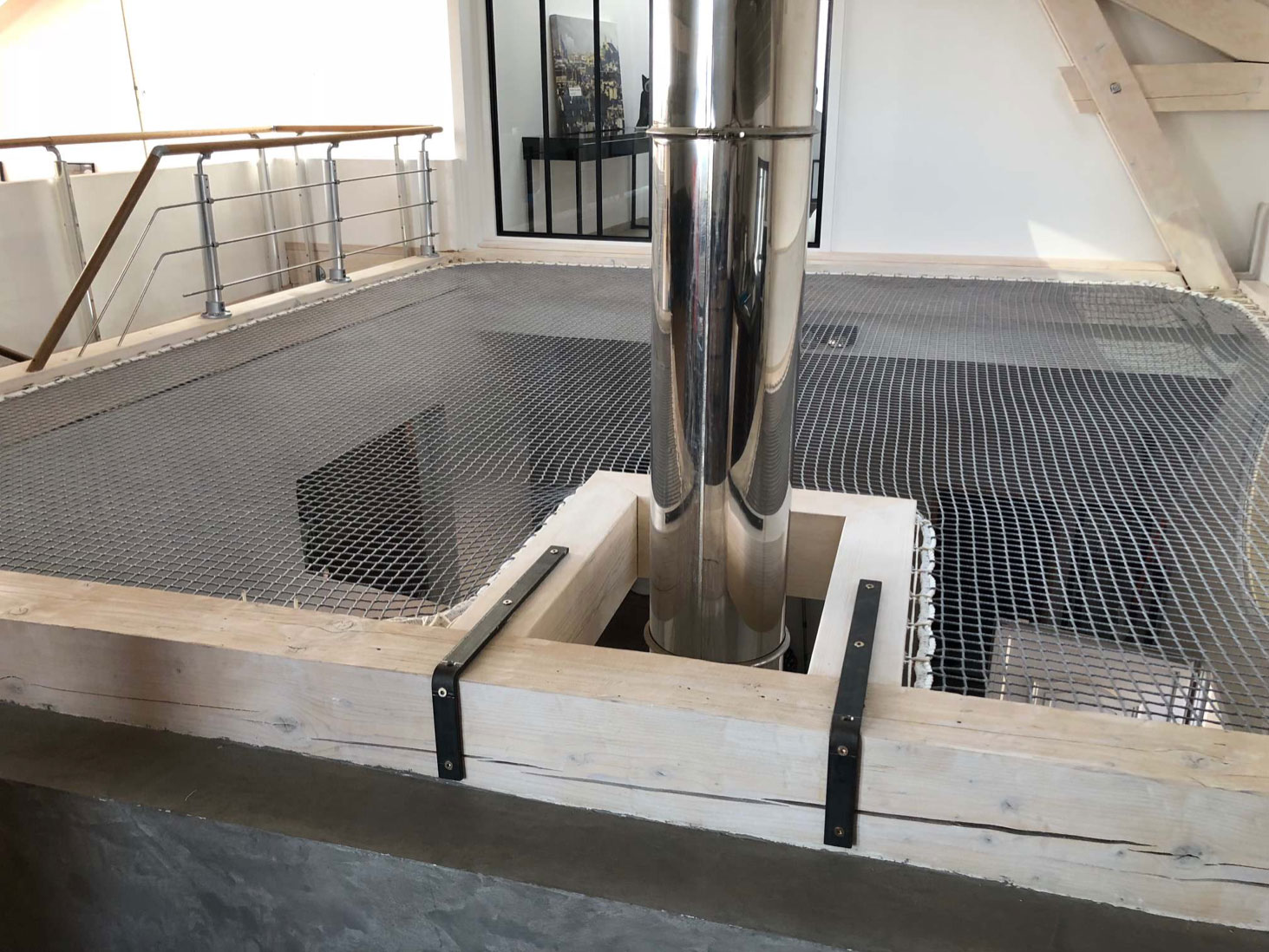
Hammock for Interior
For those of you that have bought your multi-storey apartment in a major city, and would like somewhere innovative to relax, a hammock floor that could bridge the gap between the two or more floors is an excellent choice. Essentially, it can create an open floor plan, vertically! If you have 2-3 floors, you can make part of each floor into a hammock zone. You can see all the way down from the top floor, to the ground. It's stylish, modern, contemporary and provides brilliant airflow throughout the apartment. What more can be said about it? It's a functional space, somewhere you can go to take a nap. The hammock allows your weight to sink, so your body thoroughly relaxes. That’s the secret of the hammock, you have to try it to see what we mean. Because you’re able to see throughout the home without your vision being blocked by a floor or wall, you just feel like you’re floating.
Styling the netting
Just like a hammock you would hang outside in your patio, we think that a hammock floor should be stylish. You can select any kind of color you’d like, red, yellow, blue and green are all popular choices to match your interior design ideas. The netting will be braided and because it is treated to be tough, it kind of shimmers in the moonlight so you can see it even in dim lighting. It's made out of polyester mostly, but you can have it made out of rope if you want a little extra strength. Bear in mind, that polyester is softer than rope, which may be more comfortable. However, rope is strong and durable, and less likely to stretch and or rip under pressure.
The net can support up to 240 kilos of weight, which is pretty much about 3 adults or 2 adults and a couple of young children. We think you should go for the lacing rope, which is used in maritime operations. It can withstand 3000kg and it's used to raise the sails of ships and boats. That is a lot of strength and this may be something that you are looking for if you would like to convert a large floor into a hammock floor idea.
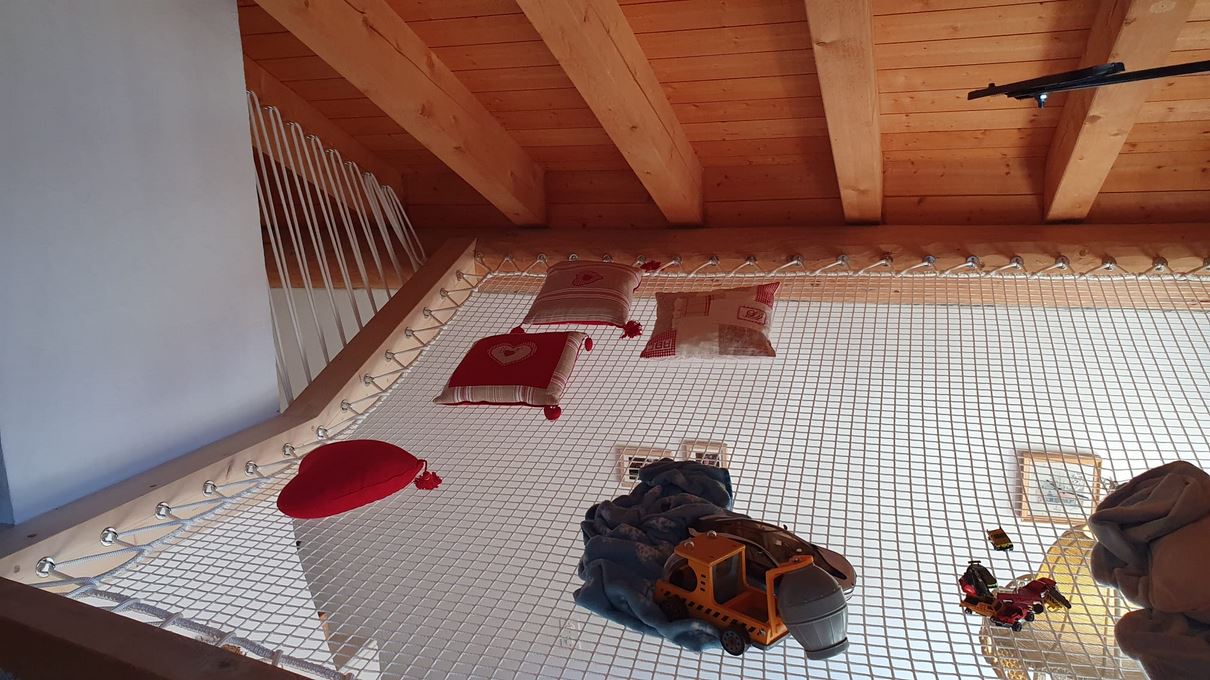
Interior Design Ideas for Modern Homes!
You can use a hammock floor for many things. Firstly, napping! Of course, those that are tired after coming home from work, but don’t quite want to go to bed before dinner, they can just grab a throw and sleep on the floor. The hammock flooring that is! Then you can also use the hammock floor for a reading nook. It's got great support, allows for natural light to filter in the room so you don’t need a lamp and you can sit or lie down as you read. There is nothing getting in the way which means you have pure freedom. This is what people only realize when they use the hammock floor for the first time, they have a sense of being suspended in space.
It's also great for a modern home design. If you would like to simply have something unorthodox and irregular to make your home unique, this is it a great choice. Those are becoming extremely popular in places like Vancouver, BC. You may also find that it's the best choice for certain rooms like those in the loft or perhaps on the first floor of a garden house. It's also just cool isn’t it? It looks like something out of a movie or dream home fantasy. And we like that!
Benefits of a custom net
You may be thinking why this is better than, maybe a floor!? Well, if you look at the benefits of style and prascticality, it makes a hammock look like the missing jigsaw puzzle in your home. We are too blocked off, too hemmed in inside our homes. The pandemic has shown us that our homes need to be our sanctuary and not just a box we get in, in between going to work and doing a bit of grocery shopping. It's also very easy to set up, it can be completed in about a day. The rope can be replaced very quickly as it's just hung onto the hooks.
It's critical that we expand our space, we allow more light into the home and allow for an open floor plan to flourish. Until now, an open floor plan has only done so, by horizontal means, connecting rooms on a single floor. But the hammock flooring allows for multiple stories to be connected and that means, better communication with people who share the home.
If you would like to know more about this unique interior design ideas, then get in touch. It adds a touch of style and abnormality that is practical to your home. We can answer any questions you may have about cost, durability and more. We are available in the US, Canada, the UK, Australia. We ship worldwide.
>> CONTACT US!
How to set up a hung mezzanine net?
How to set up a hung mezzanine net?- Can I set up a mezzanine net in the house myself? ? What fixings shall I use? Feelnets answers all your questions and tells you everything you need to know about setting up your custom mezzanine net before you start.
Let’s begin with the mezzanine net
Setting up a mezzanine net offers many advantages and enhances cosiness in your house.
The net creates a new and original indoors space. It’s a new room to chill, relax, read a book or watch a movie. Fill it with cushions and a winter fluffy blanket and you’re all set for a laid back moment in your hung net.
If you have children, it will become their new playground and the place to be anytime of the day.
On the decorative side, the net also plays its part by modifying the light and the perception of space, adding a unique touch to your interior.
The price is another big advantage! A mezzanine custom netis very affordable and offers great value for money for the advantages it brings.
Mezzanine set up as a chill zone with a Feelnets net
Read our article: How do I choose the right net?
Let’s focus now on the main subject of this article: how do I install a mezzanine net in my house?
Can I install a mezzanine net on my own?
You can install a hung mezzanine net on your own, it’s really easy to do it with a friend.
However, 96% of Feelnets customers do it themselves, so you can too!
To install the net you need to align the fixings, all around the periphery of the space, every 150 millimetres (appr. every 5,9 inches)
We have wood and concrete fixings (you will need anchors matching the material to set up your mezzanine net, they are sold apart).
Your parcel comes with installation guidelines, which include the following steps:
- How to install the fixings
- How to centre the net
- How to put tension on the rope
- How to knot the net
You don’t need special tools to set up your installation, all tools are listed in our guidelines
Woodworkers, carpenters, roofers (or other craftsmen) will know how to set up our custom nets, if you’re not feeling like doing it yourself
However, If you don’t want install your net yourself, you can use our Feelnets installers network. We can put you in touch with our indoor net installation experts who can provide you with a quote.Ask for a quote.
If you want to be part of our Feelnets installers network feel free to contact us.
Can I set up my indoor net in plasterboard walls?
It formally misadvised to set-up an horizontal net in plasterboard.
Your net will not only be fragile but also dangerous.
We strongly recommend you to use strong materials such as wood, concrete, or steel to set-up your custom net.
You will need to use the relevant fixings depending on the material that will support you net.
Feelnets can advise the best fixings solutions for your indoors custom net.
Feel free to contact us for any advice.
You can also leave a comment about this article and we will reply as soon as possible. Answers will benefit all the future readers.
How to set up a custom net in an IPN beam?
An IPN beam (with a regular I shape) is simply a steel beam.
It’s really easy to install a mezzanine custom net on an IPN beam. You will need to weld hanging points every 150 mm (every 5,9 inches) on your beam.
You can also drill the beam every 150 mm (every 5,9 inches), but make sure to perfectly sand the edges of the holesto avoid any damage to the rope.
Another way is to weld a metal bar to the beam to pass the lacing rope around it (which limits the fixings to every 150 mm)
Can I fix my custom net on three sides only?
Being on a four-sided space, you must absolutely fix all four sides of your net.
As a matter of fact, without fixings on one of the sides, your net will not be strained and will be useless. You will not be able to step on it and the tension will not be balanced.
Zinc-plated eyebolts of 8x80 millimetres (appr. 0,31 x 3,1 inches) cost less than stainless steel saddles, which offers a great saving when you have to install them all around your net.
You need to pre-drill your support, then screw all the eyebolts which takes time during the set-up.
Every eyebolt can withstand 80 kgs. (176,3 pounds)
The threaded rod is 50 mm long (1,96 inches).You need to drive it inside the wall 60-70 mm deep (up to 2,75 inches deep)
Stainless steel saddles on plates are more expensive but can improve the finish
Feelnets insists that your net should be as close as possible to the fixings to leave the minimum void possible between the edge of the net and the wall.
Stainless steel saddles on plates are sold with or without screws. The screws are 5 x 50mm (0,19 x 1,9 inches) stainless steel torx head.
Can I use eyebolts and saddles on plate?
Both of them are perfectly fit to fix indoors custom house nets or safety railing nets. However, you must be aware that the eyebolt will protrude a few millimetres.
Can I put a net outdoors?
Of course!! All our nets are UV proof, and can be set indoors or outdoors.
You can find our nets all around the world, in luxury hotels, or on the boats of our partners. (il y a un lien vers les partenaires ici)
Net Lacing
Simple or double lacing?
If you have children we advise double lacing.
Children move more than adults, and double lacing diminishes the vibrations they cause. In addition, it is more comfortable for tiny feet. Double lacing is explained in our installation booklet.
If you don’t have children you can chose simple lacing.
Can I use E 8mm lacing (0,31 inch)?
If you choose double lacing, you might want to consider using 8mm lacing, which offers a finer finish.
Can I choose between different colors and thickness?
Feelnets offers black, red, grey and blue, goingfrom 3 to 10 mm thickness (from 0,11 to 0,39 inch)
All our ropes are in polyester.
For horizontal nets, like the house net or the mezzanine net we advise 8 to 10 mm thickness (0,31 to 0,39 inch thickness)
For vertical nets like safety railings, we advise a range of between 4 and 8 mm thickness (0,15 to 0,39 inch thickness).
Guide to choose the right trampoline net for multihulls
Which trampoline net for your multihulls ?
Feelnets is a major global player in the manufacture of trampoline nets for multihulls around the world.
Lagoon, Nautitech, Catana, Fountaine Pajot, HHCatamaran, Ocean Voyager...all the biggest shipyards, Feelnets makes for you quality catamaran nets suitable for all.
Partner and supplier for many boat rental companies in the world such as Dream Yacht Charter, SK Yachting, Istion...or regatta multihulls such as the MOD70 from Maserati or from different shipyards in the world, Corthinx, HH Catamarano or Island Spirit. Feelnets takes advantage of its partners present on all the oceans to test its products in order to guarantee you a quality product adapted to your needs.
Which material for my catamaran net ?
Feelnets now offers three materials to make your multihull nets.
The Polyester material with 30x30mm or 13x13mm meshes and a 10mm diameter border.
PVC mesh from Serge Ferrari with welded and sewn edges.
Dyneema for regatta boats or other cruising multihulls.
Feelnets will recommend the best material for your boat in case of hesitation.
Nets made of 30x30mm polyester mesh.
Feelnets equips today a large part of the multihulls in the world with 30x30mm white or black polyester mesh.
This material is treated against UV rays, it is knotless to offer maximum comfort and the mesh is wide enough not to change the behaviour of your boat in the event of rough seas. It offers a good compromise between safety and comfort.
The edge of the net, also known as the headline, is a 10mm tension rope that is fixed all around the net, giving it its shape. At the time of installation, you will have to pass your rope between the fasteners on the hulls and the luff tape to tension your net.
All our nets for multihulls have a resistance of 200kg/m².
Before installing the new net, it is imperative to let it soak for 24 hours in water and then install it wet. As it dries, the trampoline will set up.
Nets made of 13x13mm polyester mesh.
The 13x13mm mesh is also made of knotless polyester and is available in black or white.
With a tighter mesh, this material offers more comfort, you will enjoy relaxing or moving around on your trampoline. Feelnets equips many yacht charter companies in the world like Dream Yacht Charter number one in the world for boat rental or shipyards like HH Catamaran with this mesh.
The resistance of the mesh of this material is 200kg/m².
Lagoon, Fountaine Pajot, Nautitech and other large shipyards also use this material to equip their catamarans.
As for the 30x30mm mesh, the net must be left in the water for 24 hours and installed soaked.
It will take its shape as it dries.
Manufacture of trampolines in PVC Mesh from Serge Ferrari.
Material PVC 492 or 392 from Serge Ferrari, extremely resistant 450kg/m², the finishes are welded and sewn.
We make trampolines with this material for private individuals and large units such as Océan Voyager, Tahiti 75, Tahiti 80, Sunreefs, Nautitech 82 and other multihulls.
This material is perfectly adapted to resist in time.
Feelnets offers welded and sewn edges.
Depending on the size of the trampolines, we offer a finish with an eyelet or with a sheath to pass rushes through. Feelnets recommends sheaths for longer lengths, you will obtain greater resistance over time and a better distribution of tension over the entire surface.
Making Dyneema nets
Feelnets makes your Dyneema netting to measure from your drawings.
It is mainly used for multihull racing boats, but many boaters and boatyards prefer this material.
Much more expensive than polyester but stronger and lighter, Dyneema is the perfect material to lighten the boat.
It is available with or without knots and in white.
Net with a 6, 8 or 10 mm diameter rope.
The dyneema 4 or 6 mm diameter tension rope is also available with Feelnets.
Our nets equip today many racing multihulls such as the Maserati MOD70 skippered by Giovanni Soldini.
To fix your net, use 4 or 6mm diameter rope.
Feelnets offers rope in several colors. On your quotation, the number of meters needed for lacing is indicated by default according to the model of your boat or the dimensions sent.
For fixing, several methods work.
Point by point fixing :
Share the rope in as many fixing points as possible on your boat. Attach the net at each fixing point using each pre-cut rope. Finish with half keys.
The lacing fastening :
Tie a knot in a corner and start lacing the rope once around the luff tape of the net (trampoline edge) and once on the boat hook and so on all around. The tensioning will be done by itself.
Why choose Feelnets quality
Feelnets is a partner with the world's number one boat rental company in the world, it guarantees us nets used every day in the 4 corners of the world in all the different climates to offer you a professionally tested product.
As a partner of Maserati and other racing multihulls, Feelnets also provides you with new and adapted products for cruising multihulls.
Buying guide trampoline nets for Lagoon catamarans
Lagoon 380, Lagoon 400, Lagoon 410, Lagoon 420, Lagoon 440, Lagoon 450, Lagoon 470, Lagoon 47, Lagoon 500… Feelnets manufactures trampoline for the whole range of the brand, from the oldest to the newest.
Across the world many Lagoon catamarans are already equipped with Feelnets nets. Not only are we trusted by boat owners but also by our partners, such as Dream Yacht Charter, the global leader for boat rental.
Dream Yacht Charter owns a significant number of Lagoon catamarans to be found in many of their rental centres.
Feelnets manufactures trampoline nets (lien)for the whole Lagoon catamarans range, in polyester or in Sergio Ferrari’s 492 prestressed PVC mesh (lien).
Our mesh is available in 13 x13 mm (0,51 x 0,51 inch) or 30x30 mm (1,18x1,18 inches), black or white.
The rope is 10 mm (0,39) thick, overlocked, for any size of mesh.
Lagoon trampolinesnets made of Sergio Ferrari’s 492 prestressed PVC mesh, come with welded and stitched edges. Eyebolts are set every 150 mm (5,9 inches) all the way round. The biggest nets come with a circlip sleeve.
Before we start manufacturing your new Sergio Ferrari’s PVC mesh trampoline, Feelnets will send you the layout for confirmation, to make sure it matches the dimensions of your trampoline.
Feelnets uses the same 30 x 30 mm (1,18 x 1,18 inches) white polyester mesh that was originally set up on Lagoon catamarans.
If you will be using your Lagoon on the sea, Feelnets advises that you use 30x30 mm mesh. If the sea conditions are strong, your trampoline net will allow the waves through and it will not alter the handling of your catamaran.
Most of the boat rental companies equip their Lagoon with 13 x 13 mm net to enhance its cosiness while mooring.
Feelnets is known and renowned among our partners for the quality of our Lagoon trampoline nets. They are the perfect upgrade when your existing Lagoon net needs to be replaced.
We can provide for any model of the Lagoon brand. Many nets are in-store, however, if your model is not it will take us 10 to 15 days to manufacture.
Feelnets delivers Lagoon nets all over the world. Our expert team will deliver your quotation within 3 hours. If your boat is in transit, we can rely on our network of partners to deliver your parcel wherever you are.
Feelnets is here for you, it’s as simple as that
Buying guide trampoline net for catamaran Fountaine Pajot
Fountaine Pajot catamarans net by Feelnets.
Fountaine Pajot, world famous catamaran maker of boats from 32 to 82 feet.
Feelnets, is partner to the biggest boat rental companies in the world, such as Dream Yacht Charter. These companies rent Fountaine Pajot catamarans on a daily basis.
Our replacement nets for Fountaine Pajot catamarans are a perfect match. They have been tested and approved by owners and Feelnets’ partners all over the world.
Feelnets manufactures Fountaine Pajot catamaran nets for Maldive32, Lavezzi40, Bélize43, Bahia46, Salina48, Ipanema, Tahiti75, and the whole range of the Fountaine Pajot brand.
Quality Fountaine Pajot nets in braided mesh polyester are available in black and white.
Feelnets also sells the lacing rope that will join your trampoline with your hull fixings. Polyester rope from 4 to 6 mm (0,15 to 0,23 inches), black or white. The necessary length will appear on your quote.
Depending on your sailing programme, Feelnets offers 13 x13 mm (0,51 x 0,51 inch) or 30x30 mm (1,18x1,18 inches) mesh.
If you will be using your Fountaine Pajot on the sea, Feelnets advises that you use 30x30 mm mesh, that will let the waves through your trampoline net and will not alter the handling of your catamaran.
To enhance the cosiness, Feelnets advise 13x13 mm mesh. You will enjoy its softness on your cruising and mooring days. We also advise Sergio Ferrari’s 492 prestressed PVC mesh with welded and stitched edges.
The edges come with eyebolts set every 150 mm (5,9 inches), all the way round. For the biggest nets, they come with a circlip sleeve.
Before we start manufacturing your new PVC mesh trampoline, Feelnets will send you the layout to make sure it matches the dimensions of your Fountaine Pajot.
Feelnets, expert in multihulls nets, can send Fountaine Pajot nets all over the world.
Feelnets holds a large amount of trampoline nets for Fountaine Pajot catamarans.
If your net is not in-store, it takes 10 to 15 days to manufacture.
Feelnets, globally known for the quality of its Fountaine Pajot nets, will reply and send your quote within 3 hours. A team of professionals is at your service to meet your needs. We deliver all around the world.
If your boat is in transit, we can rely on our network of partners to deliver your parcel wherever you are.
Feelnets is here for you, it’s as simple as that!

